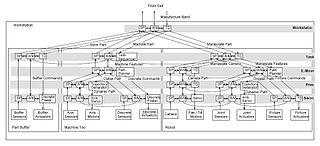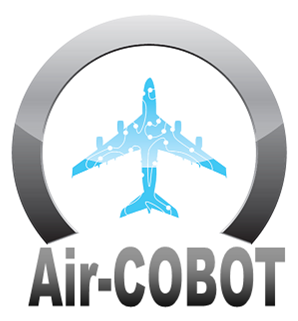Related Research Articles
Subsumption architecture is a reactive robotic architecture heavily associated with behavior-based robotics which was very popular in the 1980s and 90s. The term was introduced by Rodney Brooks and colleagues in 1986. Subsumption has been widely influential in autonomous robotics and elsewhere in real-time AI.
Behavior-based robotics (BBR) or behavioral robotics is an approach in robotics that focuses on robots that are able to exhibit complex-appearing behaviors despite little internal variable state to model its immediate environment, mostly gradually correcting its actions via sensory-motor links.

Rodney Allen Brooks is an Australian roboticist, Fellow of the Australian Academy of Science, author, and robotics entrepreneur, most known for popularizing the actionist approach to robotics. He was a Panasonic Professor of Robotics at the Massachusetts Institute of Technology and former director of the MIT Computer Science and Artificial Intelligence Laboratory. He is a founder and former Chief Technical Officer of iRobot and co-Founder, Chairman and Chief Technical Officer of Rethink Robotics and currently is the co-founder and Chief Technical Officer of Robust.AI.

A decentralised system in systems theory is a system in which lower level components operate on local information to accomplish global goals. The global pattern of behaviour is an emergent property of dynamical mechanisms that act upon local components, such as indirect communication, rather than the result of a central ordering influence of a centralised system.
In artificial intelligence, reactive planning denotes a group of techniques for action selection by autonomous agents. These techniques differ from classical planning in two aspects. First, they operate in a timely fashion and hence can cope with highly dynamic and unpredictable environments. Second, they compute just one next action in every instant, based on the current context. Reactive planners often exploit reactive plans, which are stored structures describing the agent's priorities and behaviour.
Robotics is the branch of technology that deals with the design, construction, operation, structural disposition, manufacture and application of robots. Robotics is related to the sciences of electronics, engineering, mechanics, and software. The word "robot" was introduced to the public by Czech writer Karel Čapek in his play R.U.R., published in 1920. The term "robotics" was coined by Isaac Asimov in his 1941 science fiction short-story "Liar!"
Nouvelle artificial intelligence (AI) is an approach to artificial intelligence pioneered in the 1980s by Rodney Brooks, who was then part of MIT artificial intelligence laboratory. Nouvelle AI differs from classical AI by aiming to produce robots with intelligence levels similar to insects. Researchers believe that intelligence can emerge organically from simple behaviors as these intelligences interacted with the "real world," instead of using the constructed worlds which symbolic AIs typically needed to have programmed into them.
The Johns Hopkins Beast was a mobile automaton, an early pre-robot, built in the 1960s at the Johns Hopkins University Applied Physics Laboratory. The machine had a rudimentary intelligence and the ability to survive on its own. As it wandered through the white halls of the laboratory, it would seek black wall outlets. When it found one it would plug in and recharge.

Robot localization denotes the robot's ability to establish its own position and orientation within the frame of reference. Path planning is effectively an extension of localisation, in that it requires the determination of the robot's current position and a position of a goal location, both within the same frame of reference or coordinates. Map building can be in the shape of a metric map or any notation describing locations in the robot frame of reference.
A hierarchical control system (HCS) is a form of control system in which a set of devices and governing software is arranged in a hierarchical tree. When the links in the tree are implemented by a computer network, then that hierarchical control system is also a form of networked control system.
The Distributed architecture for mobile navigation (DAMN) is a mobile robot architecture developed by Julio K. Rosenblatt at Carnegie Mellon University. DAMN consists of a collection of independently operating behaviors such as "go-to-goal" and "avoid obstacle", and an arbiter. The arbiter generates a set of feasible action possibilities for the robot over a short time horizon, and the behaviours vote on (i.e. express utility for) these candidate actions. Votes may be weighted by a mode manager. The Pareto optimal action is then sent to the vehicle controller. One method of obtaining votes is for behaviours to asynchronously update a utility map over the configuration space of the robot. The arbiter then overlays paths resulting from action candidates onto the map, and samples utilities along the paths. This approach is known as utility fusion. In DAMN, the decision-making process is distributed and asynchronous, without the need for an hierarchical structure.
The A Three-Layer Architecture for Navigating Through Intricate Situations (ATLANTIS) is a hybrid reactive/deliberative robot architecture developed by Erann Gat at the Jet Propulsion Laboratory.
The Three-Layer Architecture is a hybrid reactive/deliberative robot architecture developed by R. James Firby that consists of three layers: a reactive feedback control mechanism, a reactive plan execution mechanism, and a mechanism for performing time-consuming deliberative computations.
MIBE architecture is a behavior-based robot architecture developed at Artificial Intelligence and Robotics Lab of Politecnico di Milano by Fabio La Daga and Andrea Bonarini in 1998. MIBE architecture is based on the idea of animat and derived from subsumption architecture, formerly developed by Rodney Brooks and colleagues at MIT in 1986.

Real-time Control System (RCS) is a reference model architecture, suitable for many software-intensive, real-time computing control problem domains. It defines the types of functions needed in a real-time intelligent control system, and how these functions relate to each other.

In artificial intelligence research, the situated approach builds agents that are designed to behave effectively successfully in their environment. This requires designing AI "from the bottom-up" by focussing on the basic perceptual and motor skills required to survive. The situated approach gives a much lower priority to abstract reasoning or problem-solving skills.
An autonomous aircraft is an aircraft which flies under the control of automatic systems and needs no intervention from a human pilot. Most autonomous aircraft are unmanned aerial vehicle or drones. However, autonomous control systems are reaching a point where several air taxis and associated regulatory regimes are being developed.

Air-Cobot (Aircraft Inspection enhanced by smaRt & Collaborative rOBOT) is a French research and development project of a wheeled collaborative mobile robot able to inspect aircraft during maintenance operations. This multi-partner project involves research laboratories and industry. Research around this prototype was developed in three domains: autonomous navigation, human-robot collaboration and nondestructive testing.

Theseus is a large autonomous underwater vehicle (AUV) designed for laying fibre optic cable on the seafloor.

Genghis was a six legged insect-like robot that was created by roboticist Rodney Brooks at MIT around 1991. Brooks wanted to solve the problem of how to make robots intelligent and suggested that it is possible to create robots that displayed intelligence by using a "subsumption architecture" which is a type of reactive robotic architecture where a robot can react to the world around them. His paper "Intelligence Without Representation", which is still widely respected in the fields of robotics and Artificial Intelligence, further outlines his theories on this.
References
- 1 2 3 4 5 Brooks, R.A. (1990). "Elephants Don't Play Chess" (PDF). Designing Autonomous Agents: Theory and Practice from Biology to Engineering and Back. 6 (1–2): 3–15. CiteSeerX 10.1.1.588.7539 . doi:10.1016/S0921-8890(05)80025-9 . Retrieved 2009-02-05.
- 1 2 Brooks, R. (1986). "A robust layered control system for a mobile robot" (PDF). IEEE Journal of Robotics and Automation. 2 (1): 14–23. doi:10.1109/JRA.1986.1087032. hdl: 1721.1/6432 . S2CID 10542804 . Retrieved 2009-02-04.